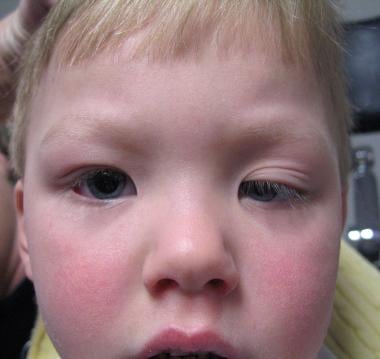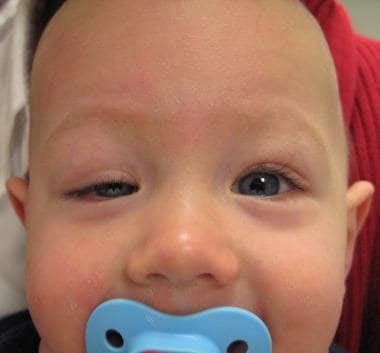Background
A drooping eyelid is called ptosis or blepharoptosis. In ptosis, the upper eyelid falls to a position that is lower than normal. Severe ptosis may cover part or all of the pupil and interfere with vision, resulting in amblyopia. [1, 2, 3] Note the images below:
Ptosis can affect one eye or both eyes and can present at birth or be more apparent later in childhood. Ptosis that is present at birth or within the first year of life is called congenital ptosis. Most cases of congenital ptosis are isolated and do not affect vision, but refractive errors and amblyopia should always be excluded. [1] Any ptosis that develops over a period of days or weeks can signal a serious medical problem and needs further neurologic and physical evaluation.
Pathophysiology
The eyelids are elevated by the contraction of the levator palpebrae superioris.
In most cases of congenital ptosis, a droopy eyelid results from a localized myogenic dysgenesis. Rather than normal muscle fibers, fibrous and adipose tissues are present in the muscle belly, diminishing the ability of the levator to contract and relax. Therefore, the condition is commonly called congenital myogenic ptosis.
Congenital ptosis can also occur when the innervation to the levator is interrupted through neurologic or neuromuscular junction dysfunction. Some forms of congenital ptosis may represent a form of congenital cranial dysinnervation disorder. [4]
Epidemiology
Frequency
United States
The frequency of congenital ptosis in the United States has not been officially reported. However, in approximately 70% of known cases, congenital ptosis affects only one eye.
International
The incidence rate of congenital ptosis worldwide is unknown.
Mortality/Morbidity
If congenital ptosis obscures any part of the pediatric patient's visual field, surgery must be performed to correct the problem early in life. Otherwise, a permanent loss of vision may occur as a result of amblyopia. Note the following:
-
Occlusion amblyopia
-
Astigmatism from the compression of the droopy eyelid
-
Ocular torticollis
Race
Congenital ptosis occurs equally among the different races.
Sex
Congenital ptosis occurs equally between males and females.
Age
Congenital ptosis is usually present at birth but may manifest within the first year of life.
Prognosis
The repair of congenital ptosis can produce excellent functional and cosmetic results.
With careful observation and treatment, amblyopia can be treated successfully.
Of patients who require surgical intervention, 50% or more may require repeat surgery in 8-10 years following the initial surgery.
Patient Education
Although not all patients with congenital ptosis need surgical intervention, patients need to be closely monitored for the possible development of deprivational amblyopia. Since amblyopia may not be reversed after age 7-10 years, appropriate and timely medical and surgical treatment of congenital ptosis is critical to preserve the child's vision.
Uncorrected congenital ptosis can result in amblyopia secondary to deprivation or uncorrected astigmatism.
An abnormal eyelid position can have negative psychosocial effects.
Uncorrected acquired blepharoptosis results in decreased field of vision and frontal headaches.
-
Chin-up posture due to congenital ptosis of the left eye.
-
Congenital ptosis of the left eye partially obstructing the left pupillary axis.
-
Congenital ptosis of the right eye.











